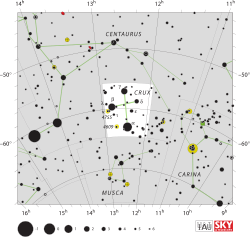Delta Crucis
| Observation data Epoch J2000 Equinox J2000 |
|
|---|---|
| Constellation | Crux |
| Right ascension | 12h 15m 08.71673s |
| Declination | –58° 44′ 56.1369″ |
| Apparent magnitude (V) | 2.79 |
| Characteristics | |
| Spectral type | B2 IV |
| U−B color index | –0.921 |
| B−V color index | –0.235 |
| Variable type | β Cep |
| Astrometry | |
| Radial velocity (Rv) | +22.2 km/s |
| Proper motion (μ) |
RA: -35.81 mas/yr Dec.: -10.36 mas/yr |
| Parallax (π) | 9.45 ± 0.15mas |
| Distance | 345 ± 5 ly (106 ± 2 pc) |
| Absolute magnitude (MV) | –3.2 |
| Details | |
| Mass | 8.9 ± 0.1 M☉ |
| Radius | 8.0 R☉ |
| Luminosity | 10,000 L☉ |
| Surface gravity (log g) | 3.88 cgs |
| Temperature | 22,570 ± 1,840 K |
| Rotational velocity (v sin i) | 210 km/s |
| Age | 18.1 ± 3.2 Myr |
| Other designations | |
| Database references | |
| SIMBAD | data |
Delta Crucis (δ Cru, δ Crucis) is a star in the southern circumpolar constellation of Crux. It is sometimes called Pálida (Pale [one]) in Portuguese. This star is of apparent magnitude 2.79 and is located at a distance of about 345 light-years (106 parsecs) from Earth, the faintest of the four bright stars that form the prominent asterism known as the Southern Cross. Delta Crucis is massive, hot and rapidly rotating star that is in the process of evolving into a giant.
This star has a stellar classification of B2 IV, making it a subgiant star that is in the process of evolving away from the main sequence stage. It is now developing into a red giant and will one day end as a white dwarf. Presently it is radiating around 10,000 times the luminosity of the Sun from its outer atmosphere at an effective temperature of 22,570 K, causing it to glow with a blue-white hue. Delta Crucis is a strong candidate Beta Cephei variable and changes its brightness subtly with a period of 1.3 hours. Its rotation is very fast, with a projected rotational velocity of 210 km s−1.
Delta Crucis is a member of the Lower Centaurus Crux (LCC) component of the Scorpius-Centaurus Association, which is an OB association of massive stars that share a common origin and motion through space. This is the nearest OB association to the Sun, with the LCC component having an age in the range of 16–20 million years.
...
Wikipedia

